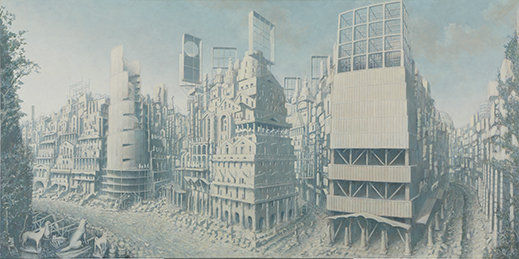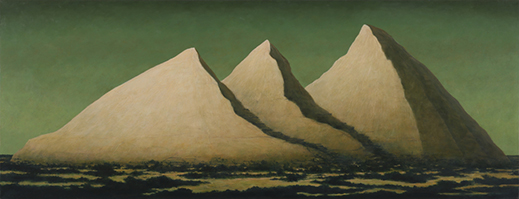| |
|
Here and There introduces art, artists, galleries, museums, and other cultural facilities around Japan that non-Japanese readers and first-time visitors may find of particular interest.
|
|
 |
|
|
 |
 |
Things Fall Apart: The Prophetic Art of Minoru Nomata
Alan Gleason |
 |
Gekka-4 (2022), © Minoru Nomata |
Minoru Nomata's current solo exhibition at Taro Nasu gallery in Roppongi, Tokyo, features six new paintings that revisit his familiar motifs of imaginary architecture and surreal geometric forms, but with some subtle differences. Facing the entrance from the far wall is a two-meter-high painting of a soaring Babel-like tower, an image he has returned to frequently over the years. Nomata often portrays his fantasy structures in various stages of incompletion. Even so, this Babel stands out for its thoroughly ambiguous condition.
|
 |
|
|
|
Gekka-2 (2022), © Minoru Nomata
|
At the base, part of the façade appears to have sloughed off into a pile of rubble, yet the upper floors remain intact. Near the top, the symmetrical rows of windows and columns taper off into a dark, amorphous mass covered with a scaffold of planks and stairs, terminating in a jagged mountain peak that does not resemble a building at all. From this zenith, a cascade of light pours down one side to the bottom.
Nomata says the ambiguity is intentional: "I like to look at buildings that are under construction. They promise hope for the future, but also prompt one to ask, 'Is this really needed?' This tower could still be a work in progress, or it could be abandoned -- or it could be a natural mountain. It's up to the viewer."
The tower painting is not the only one that hints at things falling apart. A tall greenhouse-like structure struggles to contain a surging mass of foliage that pushes its way out through the lattices. A row of mammoth white cones and spheres lie broken in pieces, like relics of a civilization that worshipped geometry. What is striking is how different these compositions are from those in his previous solo show in Tokyo, held in 2018 at Sagacho Archives. Those paintings all featured abstract spherical shapes floating in the sky above an expanse of land or sea. Tethered by ropes to the ground, they resembled weather balloons, but devoid of any identifying marks. Pure in form, the spheres and their backdrop of sunlit clouds suggested something eternal and life-affirming. (Some of these images can be seen in this 2018 Here and There review.)
|
 |
|
|
|
Gekka-1 (2022), © Minoru Nomata
|
Asked about the marked departure in his latest work from those ethereal scenes of four years ago, Nomata explains that his thematic interests began changing even before that, and in some ways his current efforts are a return to past motifs. Like the paintings at Taro Nasu, his earlier works portrayed monumental structures of his own invention, either complete or in the process of construction, but always in a pristine state. "I'm an admirer of architecture, and also a fan of speculative fiction by writers like Philip K. Dick," he says. "I wanted the structures I invented to embody the grandeur of human hopes, but also the excesses of human ambition. My critique, if any, was directed at the destructive effects of people on the environment. But the earthquake, tsunami, and nuclear disaster of March 2011 came as a shock to me, not least because the destruction was caused by the Earth itself."
Gekka-3 (2022), © Minoru Nomata |
Soon after 2011, Nomata painted a trio of homages to Giovanni Battista Piranesi, the 18th-century Italian artist and architect famed for his fantasy-infused etchings of ancient Roman ruins. One of the three, Listen to the Tales (2013), depicts a curiously baroque-modern cityscape with buildings in various states of disrepair, streets filled with rubble, and no humans in sight. Little clues reveal that the setting is Tokyo's iconic Shibuya crossing, but with its bustling heyday a thing of the remote past. The atmosphere, and the composition itself, are clearly inspired by Piranesi's Ancient Intersection of the Via Appia and the Via Ardeatina (1756).
 |
|
Listen to the Tales (2013), © Minoru Nomata, courtesy of the artist |
|
 |
|
|
|
Gekka-6 (2022), © Minoru Nomata
|
As time went on, however, Nomata says he came to feel that buildings were a kind of illusion, and he lost interest in architecture. He had always favored spheres, both as structures and in the form of large airborne balloons. Now he began painting "balloons" devoid of architectural references. "I saw them as something transcendent, beyond architecture -- or pre-architecture, as in the archetypal shape of the planet." This longing for some kind of transcendence was the impulse that gave birth to the works I saw at Sagacho Archives in 2018.
So why has he gone back to creating buildings and towers? Perhaps, Nomata says, it was time for him to revisit his first love, architecture -- spurred in part by awareness of his advancing age (he is 67). But it also seems to reflect a darker perception of the state of the world and its future prospects. Though he still composes his fantastic structures with elaborate flourishes and impeccable draftsmanship, they are no longer immune to abandonment and decay. At the same time, these works reference the broader, even mystical perspective embodied in those balloon-like spheres, though it is not obvious at first glance.
That long-term view of our destiny is hinted at in the titles of his new works, Gekka-1 through Gekka-6. Gekka means "under the moon," which is, in fact, the name of the exhibition. Yet the scenes in these paintings are illuminated by sunlight, though the sun is not visible -- but then again neither is the moon. Nonetheless, Nomata avers, the moon is a presence in all of them. "The moon represents something constant. Life on Earth advances and retreats, but the moon doesn't change. While earthly civilizations come and go, the moon remains uncivilized." Let us not forget, he adds, that terrestrial life itself may have come from a comet that crashed into the Earth.
 |
|
Gekka-5 (2022), © Minoru Nomata |
All works shown are by Minoru Nomata; photos are by Keizo Kioku or Nomata Works & Studio, courtesy of Taro Nasu.
|
 |
| Minoru Nomata: Gekka (under the moon) |
| 21 January - 19 February 2022 |
| Taro Nasu |
Piramide Bldg. 4F, 6-6-9 Roppongi, Minato-ku, Tokyo
Phone: 03-5786-6900
Open 11 a.m. to 7 p.m.; closed Sunday, Monday, and public holidays
Access: 2-minute walk from Exit 1 or 3, Roppongi Station on the Tokyo Metro Hibiya Line or Toei Subway Oedo Line
|
|
|
|
| |
 |
Alan Gleason
Alan Gleason is a translator, editor and writer based in Tokyo, where he has lived for over 30 years. Since 2006 he has edited artscape Japan and written the Here and There column, as well as translating the Picks reviews. He also edits and translates works on Japanese architecture, music, and theater. |
|
|
|
|
|
|
|
|
|
 |
|